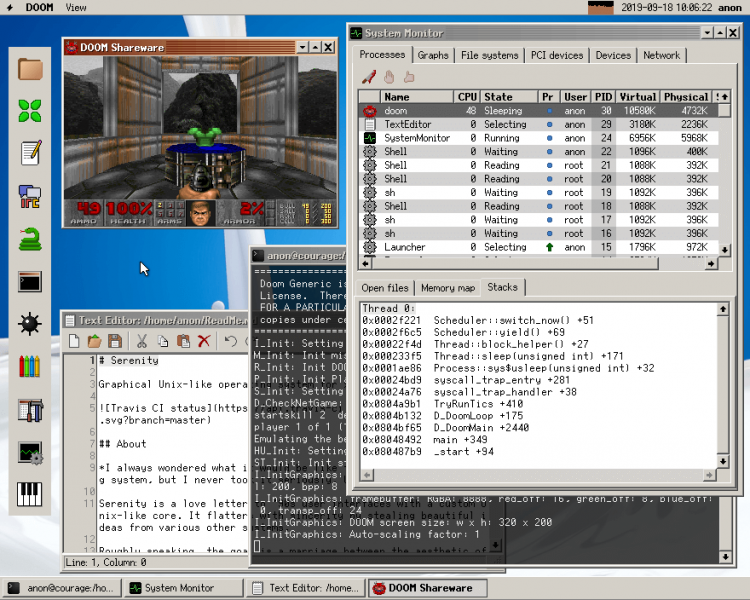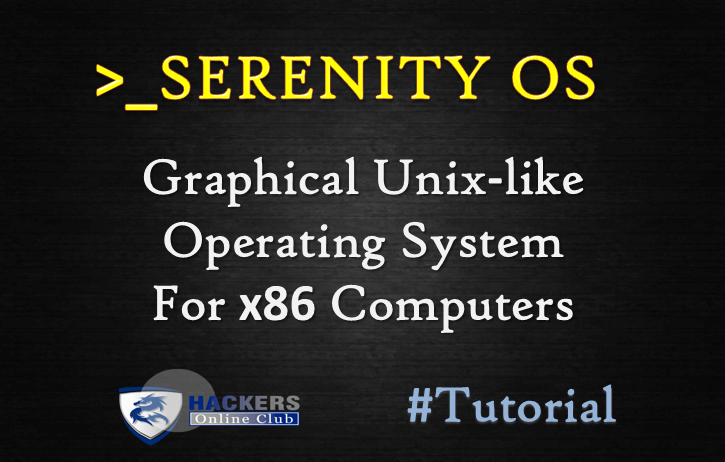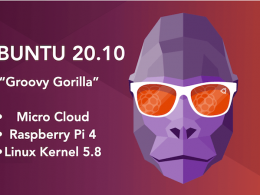Serenity an operating system Graphical Unix-like Operating System For x86 Computers
Current features
- Pre-emptive multitasking
- Multithreading
- Compositing window server
- IPv4 networking with ARP, TCP, UDP and ICMP
- ext2 filesystem
- Unix-like libc and userland
- POSIX signals
- Shell with pipes and I/O redirection
- mmap()
- /proc filesystem
- Local sockets
- Pseudoterminals (with /dev/pts filesystem)
- Filesystem notifications
- JSON framework
- Low-level utility library (LibCore)
- Mid-level 2D graphics library (LibDraw)
- High-level GUI library (LibGUI)
- Emojis (UTF-8)
- HTTP downloads
- SoundBlaster 16 driver
- Software-mixing sound daemon
- WAV playback
- Simple desktop piano/synthesizer
- Visual GUI design tool
- PNG format support
- Text editor
- IRC client
- Simple painting application
- DNS lookup
- Desktop games: Minesweeper and Snake
- Ports system (needs more packages!)

How do I build and run this?
Make sure you have all the dependencies installed:
sudo apt install build-essential curl libmpfr-dev libmpc-dev libgmp-dev e2fsprogs qemu-system-i386 qemu-utils
Ensure your gcc version is >= 8 with gcc –version. Otherwise, install it (on Ubuntu) with:
sudo add-apt-repository ppa:ubuntu-toolchain-r/test sudo apt-get install gcc-8 g++-8 sudo update-alternatives --install /usr/bin/gcc gcc /usr/bin/gcc-8 800 --slave /usr/bin/g++ g++ /usr/bin/g++-8
Go into the Toolchain/ directory and run the BuildIt.sh script. Then source the UseIt.sh script to put the i686-pc-serenity toolchain in your $PATH.
Once you’ve done both of those, go into the Kernel/ directory, then run ./makeall.sh, and if nothing breaks too much, take it for a spin by using ./run.
You can vastly reduce the build time of successive rebuilds of Serenity by installing ccache and exporting PRE_CXX=ccache
Bare curious users may even consider sourcing suitable hardware to install Serenity on a physical PC.
Later on, when you git pull to get the latest changes, there’s no need to rebuild the toolchain. You can simply rerun ./makeall.sh in the Kernel/ directory and you’ll be good to ./run again.
Also See – Advance Operating System
Notes on WSL
SerenityOS can also be built and run under WSL Version 2. WSL Version 1 is not supported since Version 1 does not support ext2, which is needed for the setup.
WSL Version 2 is currently only available for Insider Builds of Windows which are more unstable and prone to crashes. Therefore, running SerenityOS on WSL Version 2 and running Insider Builds, in general, is not recommended on production systems.
Nevertheless, here is a guide on how to get an Insider Build and how to get WSL2. The installation then proceeds as usual.
WSL2 does not natively support graphical applications. This means that to actually ./run SerenityOS, you need an X Server for windows. Vcxsrv is a good option. When you start up Vcxsrv, make sure to set the Display number to 0, and to Disable access control. Before actually doing ./run, you need to set the DISPLAY environmental variable as such:
export DISPLAY=$(cat /etc/resolv.conf | grep nameserver | awk '{print $2}'):0
This is due to a bug in WSL2. For more information, microsoft/WSL#4106.
Now you can finally, ./run.
The author of Serenity operating system is Andreas kling











